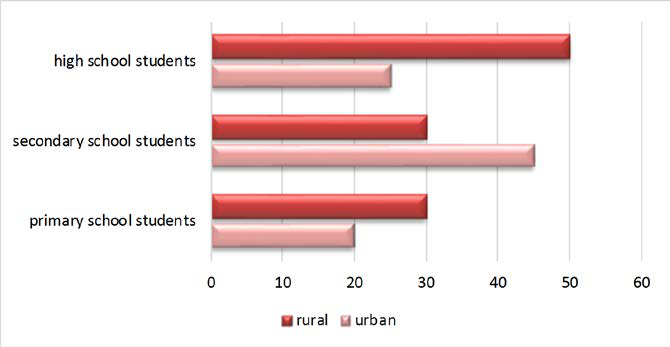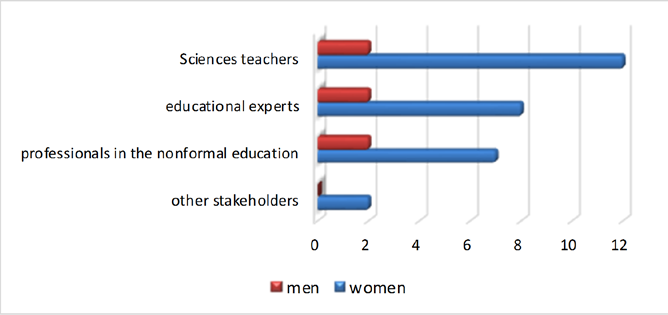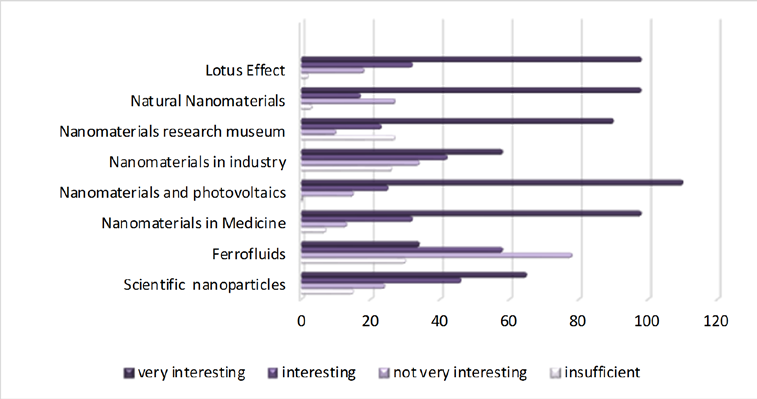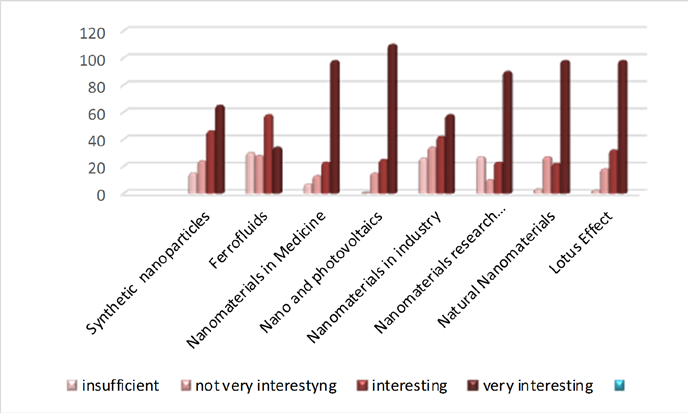Responsible Research and Innovation in the Context of Educational Partnership - A Case Study Oriented on a Training Module Related to Nanomaterials
Abstract
The paper illustrates the results of a research which aimed to perform a diagnosis made in the frame of the FP7 project called IRRESISTIBLE, being oriented on the training module related to
Keywords: Formal educationnon-formal educationResponsible Research and Innovation feedback analysisIRRESISTIBLE project
Introduction
The present orientations in the paradigm of teaching underline a displacing of the accent from the
normative, passive didactics, towards a descriptive, explicative didactics with a powerful prescriptive
character. Within this framework, we are thus able to refer to a new paradigm of didactics: the
psychological-active paradigm. The modern didactics demand the permanent improvement and
adaptation of the learning activities as a consequence of the scientific evolution, development, research
and progress, the correct understanding of the human behavior, the accurate understanding of the
human organism psychical functionality, understanding the actual environment factors and their
influence upon human development, progress in the neurosciences research field, the individual’s
expectations reported to life, the individual’s normal functioning as a social integrated whole. Many
researchers were preoccupied of identifying explanations regarding the correlation between different
learning structures. According to Thorpe & Schmuller (apud Neacșu, 2015), we identify the following
learning principles and laws: learning must begin from the establishing of a purpose; any learning
begins with different means of using the subject’s experience; learning has a neurophysiological basis,
thus a material substrate; learning is strongly influenced by the affective states generated by the
situations and conditions which appear during the process; learning develops and is also positively
influenced by a socio-cultural system of stimulation which is called
efficient whilst developing an action; learning is influenced by the ageing general and partial processes;
learning is directional and determined by knowledge. In the teaching paradigm, the act of “teaching”
has the following steps: to present facts, examples, models, exponents, offcuts from reality; to lead
pupils towards their analysis, to compare them, to explain; to draw the essential which to be focused in
definitions, laws, rules, principles; to organize the act of learning; to activate knowledge in exercises,
applicative activities (Ionescu & Bocoș, 2009). Within this frame, the formal and non-formal
educational partnerships converge towards achieving a sustainable education. We define educational
partnership as the explicit and implicit accord between formal and non-formal type of educational
actors, active on developing educational activities with an important role on forming and developing
cognitive, attitudinal, instrumental applicative and reflexive competences, demanded by the need of
functioning confronted with the new social and progress realities.
Research methodology
The present research proposes to accomplish a diagnosis within the European FP7 project named
IRRESISTIBLE, taking into evidence the dedicated Training Module on Nanomaterials, concerning
the results obtained during the specific activities accomplished in the frame of project educational
partnership (university, schools, museum, Research institute). For this purpose, there were formulated
specific research objectives: (a) analyzing the perception of direct beneficiaries learning experiences
concerning the active involvement in the project (students, specialists, teachers) -
the representation of the actors involved in the project concerning the impact of the activities on the
personal professional activities -
benefits identified by the means of the activities accomplished during the project -
the project added value based on a set of quantifiable indicators (baseline indicators) -
research is mixes: qualitative and quantitative, and the proposed instruments are: specific
questionnaires and semi-structured interview. The participants to the research were: students, teachers,
researchers from the pre-university and university educational environment. The quantitative research
allowed the measurement of the beneficiaries’ level of interest in the project, towards disseminating the
products of learning. The structure of the sample is: (a) students (200 - from pre-university educational
levels: primary (50), lower secondary (75), upper secondary (75); (b) members of the Community of
Learners (35 - Science teachers - Physics, Chemistry, Biology, educational experts, researchers,
specialists from museums and libraries) - set up in the frame of the project. The whole group took part
at the formal and non-formal educational activities during the project. The distribution of the sample is
illustrated in figures


Results and discussion
The formal and non-formal educational activities aimed to the implementation of the knowledge
concerning the acknowledgement of the importance of valorizing the benefits offered by the Nano-
world, together with the advantages of nanotechnology / nanomaterials, all of them being enrich with
Responsible Research and Innovation issues. The thematic included in the
Teaching Module named:“Nanomaterials and its applications” consists of the following subjects:
“Natural nanomaterials”, “Lotus effect”, “Nanoparticles”, “Ferrofluids” (formal educational
activities), and “Applications of nanomaterials in medicine”, “Applications of nanomaterials in solar
energy systems”, “Applications of nanomaterials in industry”, “Applications of nanomaterials in the
develop cognitive competences: knowing, understanding and using the specific language, interpreting
the knowledge, but also educational competences: applying, transferring and problem-solving, critical
and constructive reflecting, creative-innovative behaviouring. The non-formal type activities allowed
the formation at the students’ level of transversal competences: role competences and also personal and
professional development ones. To each competence, it corresponds a series of descriptors. In this
respect, there were projected research instruments which allowed the measurement of the level of the
gained competences, using a Likert type-scale. The following working hypothesis was considered: if in
the formal and non-formal educational activities, the teachers use the experiential pedagogy in the
didactic process, then the students will easily understand the knowledge related to nanomaterials and
the projected competences will be developed. The operationalization of the cognitive competence
dimensions aimed to: minimal knowledge about each topic, knowledge related to the concept of
nanotechnology, acknowledging the importance of using nanotechnology, possibility of giving
examples related to applications of nanomaterials in various areas, knowing the importance of
nanotechnology for the human progress, expressing some value judgments regarding the need to know
the importance of using nanotechnology in the everyday life. At the level of the functional action
competences, it was especially pursued the perception of the manner in which students can apply,
transfer and solve certain problems in the context of valorizing information regarding nanotechnology,
have a creative and innovative behaviour about particularizing in several life contexts the learning
results, have a critical and constructive reflection reported to the decisions taken about selecting
information and its use in the personal space. In this respect, figure
on a large scale all the topics, but mainly those connected to the
effect”, “Applications of nanomaterials in medicine”, “Applications of nanomaterials in solar energy
systems”, and “Applications of nanomaterials in the museum research”, the last three ones probably to
the fact that during the non-formal activities, the students took part actively, being involved in direct
activities like observation, experimentation, asking for information from other specialists (researchers).
Those ones were able to facilitate the students’ access to the information derived from valid
experiments and have exemplified the manner in which this can be valorized in the everyday life. In
conclusion, the identification and correlation of the gathered knowledge related to its use in the
students’ everyday life, increased their interest for learning and representing a fundament for
sustainable education.

At the teachers’ level, it was measured their perception regarding the didactic strategies used on
building competences for each theme from the module:“
this framework, it was considered the following explicative paradigm: the field is hard to be understood
by the students, due to the lack of adequate resources, and the didactic strategies must aim to design
learning activities based on the models which to aim to: observation, experiment, explanation, reflexive
approach, debate. The perception of the learning activities, as perceived by the Community of Learners
members, is illustrated in figure

In conclusion, we may assert the fact that, at the perceptual level, from the perspective of the high
degree of didactic availability on implementing the presented thematic, the teachers’ opinion converge
with the perceptual level of the competences gained by the students, which leads to the following fact:
the didactic demarche, the multidisciplinary approach and the presence of the team of
specialists/experts in formal and non-formal education activities, condition the success on gaining of
new competences by the students (OS1, OS2, OS3). Presenting information from the perspective of its
use in the personal life, enhance the students’ curiosity, interest and active participation to the learning
process. Those aspects represent precursors of sustainable education.
Regarding the measurement of the project added value, based on a set of quantifiable indicators
(baseline indicators) - OS4, it was considered the following explicative paradigm: the discoveries from
the nanotechnology field represents an issue frequently used by the society and valorized by the
science, in the benefit of all the citizens, by respecting the principles of governance, equality and
accessibility. A form of an education dedicated to “nano” world represents a successful key on
acknowledging the importance that nanotechnology has in the societal progress, environmental
protection, health and increasing the quality of life, preserving the natural and environmental resources.
In this way, the project added value is justified: beyond the importance of the field, the students proved
to be an active part because they were actively involved in the experimental part, in making samples, in
organizing exhibitions, in building investigation demarches based on the problems solving models and
learning by discovery, in valorizing the available material resources, all of those facts governed by the
dimensions of Responsible Research and Innovation: implication/engagement, gender equality, ethics,
governance, accessibility, scientific education, sustainability and social justice. Education in the non-
formal space, can valorize the dimensions of RRI by the adequate use and exploitation of the methods
of stimulating learning at the trainees’ levels (Anghel, Gorghiu, & Măntescu, 2015).
Conclusion
We observe that the educational activities developed within the IRRESISTIBLE project led to a
successfully learning demarche. Experiential pedagogy made the students manifest an increased
interest towards learning, given the conditions they are the direct beneficiaries of some concrete
learning activities, based on experimentation. The education made especially in non-formal settings
adds real values and complement the formal one. The consolidation and building of students’
educational competences within such modules (like “
in the context of a mixt-type educational design, in which the formal educational models are completed
by non-formal educational activities.
Acknowledgements
This work was funded through the Seventh Framework Programme Project “
References
- Anghel, G.A., Gorghiu, G., Măntescu, G. (2015). Valorization of RRI Dimensions in Non-Formal Education. A Case Study Related on a Thematic Exhibition in Museum. 7th Lumen International Conference: “Multidimensional Education & Professional Development. Ethical Values”, November 12th-14th, 2015, Targoviste, Romania.
- Ionescu, M., & Bocoș, M. (2009). Tratat de didactică modernă. Pitești: Paralela 45.
- Neacșu, I. (2015). Metode și tehnici de învățare eficientă. Iași: Polirom.
Copyright information

This work is licensed under a Creative Commons Attribution-NonCommercial-NoDerivatives 4.0 International License.
About this article
Publication Date
04 October 2016
Article Doi
eBook ISBN
978-1-80296-014-3
Publisher
Future Academy
Volume
15
Print ISBN (optional)
-
Edition Number
1st Edition
Pages
1-1115
Subjects
Communication, communication studies, social interaction, moral purpose of education, social purpose of education
Cite this article as:
Anghel, G. A., Gorghiu, L. M., & Măntescu, G. (2016). Responsible Research and Innovation in the Context of Educational Partnership - A Case Study Oriented on a Training Module Related to Nanomaterials. In A. Sandu, T. Ciulei, & A. Frunza (Eds.), Logos Universality Mentality Education Novelty, vol 15. European Proceedings of Social and Behavioural Sciences (pp. 62-68). Future Academy. https://doi.org/10.15405/epsbs.2016.09.8

